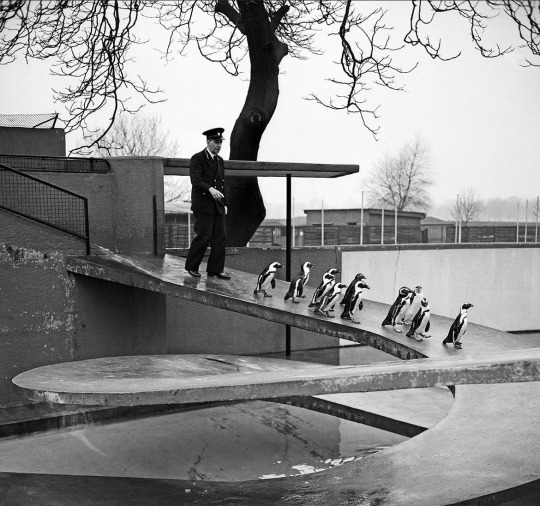#lubetkin
Text



lubetkin penguin pool, london zoo. by berthold lubetkin (1934)
152 notes
·
View notes
Text
Scanning the 50th Anniversary of the Bar Code
Steve chats with Paul McEnroe, the leader of the IBM team that invented the bar code, and the author of the new memoir, "The Barcode: How a Team Created One of the World's Most Ubiquitous Technologies"
It may be hard to believe but this year marks the golden anniversary of a ubiquitous piece of technology that doesn’t have to boot up, doesn’t need a battery recharge, never needs a new style of USB cable, and has baffled an American president.
It’s the bar code, those vertical lines of varying thicknesses that you see with a bunch of numbers on just about every package of goods you buy in a…

View On WordPress
0 notes
Text
Watching this doc about the comedy store and somehow it spends like less than 15 minutes on the comedy strike which is nuts and I’m sure has nothing at all to do with the fact that the guy who made it was one of the guys who broke the strike… also how are you going to barely talk about Steve Lubetkin at all the most interesting thread of the whole story. And praise Mitzi Shore so much and not even bring up the fact she was making piles of money off these people and refused to even just give them a cut of the cover charge. WHATEVER!!!
#my interest in learning more about Richard Lewis has snowballed into something else….#this kind of thing is such a pet peeve of mine like there’s such an interesting story here but you’re choosing the easy to digest one that#makes you feel better about urself and simplfy lubetkin as a guy with mental health issues w/o even#mentioning how getting blackballed for striking played in a role in that
7 notes
·
View notes
Photo










1012. Berthold Lubetkin & Tecton /// Hillfield (House A) /// Whipsnade Zoo Estate, Dunstable, Bedfordshire, UK /// 1933-36
OfHouses presents: Readings, part I - Kenneth Frampton, The Other Modern Movement.
(Photos: © Dell & Wainwright. Source: RIBA Collections.)
#Readings1#Berthold Lubetkin#Tecton#UK#30s#OfHouses#oldforgottenhouses#www.ofhouses.com#thecollectionofhouses
80 notes
·
View notes
Text

Penguins inspect a model made by Berthold Lubetkin of a new proposed enclosure at London Zoo.
17 notes
·
View notes
Text

Today marks the 45th anniversary of the death of Cywia Lubetkin - the heroine of the Warsaw Ghetto Uprising and the Warsaw Uprising.
Cywia Lubetkin was born in 1914 in Byteń near Słonim, where she grew up. From 1938 she lived in Warsaw, where she was involved in the activities of the socialist youth organization Dror. After the outbreak of World War II, she made her way from Warsaw to Kowel, which was occupied by the Soviet army, but at the beginning of 1940, at the behest of an organization that lacked proven leaders, she returned to Warsaw.
She was a co-founder of the Anti-Fascist Block, created in the Warsaw Ghetto in the spring of 1942, and a co-organizer of the Jewish Combat Organization, whose shape and policy she had a significant impact on. It was a member of the Jewish National Committee and the Jewish Coordination Commission - an organization associating all groups of the Jewish underground.
She participated in the January self-defense - the first act of armed resistance in the Warsaw Ghetto in January 1943 - and then in the Warsaw Ghetto Uprising. For some time she hid in a bunker at ul. Miła 18, and then she got through the sewers to the "Aryan side". She fought in the Warsaw Uprising in a unit of the People's Army.
After the war, she was active in the Zionist Coordination (Bricha), organizing trips of Jews from Poland, in 1946 she participated in the Zionist Congress and in the same year herself - together with her husband Icchak Cukierman - she lived in Palestine. She was a witness in the trial of Adolf Eichmann in 1961. Involved in the kibbutz movement, she was a co-founder and resident of the Lochamej ha-Getaot (Ghetto Fighters) kibbutz, where she died on July 10, 1978.
Grandchildren of Holocaust Survivors
25 notes
·
View notes
Photo

Type C House, Sussex. Lubetkin & Tecton, 1935. via RIBA pix
361 notes
·
View notes
Text



Colour wheel art challenge, C20 architects edition! 👔🎨
Had a lot of fun with this — list of people under cut.
Instagram // Twitter // VK // ArtStation // Mastodon
❤️ Berthold Lubetkin (Tecton; Skinner Bailey and Lubetkin)
🧡 Andy MacMillan and Isi Metzstein (Gillespie Kidd and Coia)
💛 [left to right] Stan Amis, John Partridge, Bill Howell and John Killick (Howell Killick Partridge and Amis)
💚 Hugh Casson and Neville Conder (Casson Conder Partnership)
🩵 Hidalgo Moya and Philip Powell (Powell and Moya)
💙 Geoffry Powell (Chamberlin Powell and Bon)
💜 Gordon Benson and Alan Forsyth (Benson and Forsyth)
🩷 Peter Womersley
#artists on tumblr#illustration#architecture illustration#berthold lubetkin#gillespie kidd and coia#howell killick partridge and amis#hkpa#casson conder partnership#powell and moya#chamberlin powell and bon#benson and forsyth#peter womersley#colour wheel challenge#colour wheel meme#cyhsal
7 notes
·
View notes
Text
its kind of a shame that 1930s style modernism isn't as widely enjoyed or ingrained in the public conscience bc its ideological foundations kind of rule.
2 notes
·
View notes
Text

Bevin Court (1946—54) — Berthold Lubetkin
9 notes
·
View notes
Note
I want to echo all the nice things people have said about your work, and add one more: I appreciate that your blog offers space to mourn the Holocaust. Not the Holocaust as a metaphor, not the Holocaust as a rhetorical invocation, but the Holocaust in and of itself. It provides a sobering kind of relief. When I was a kid learning about the Holocaust, my classes always showed me Life is Beautiful and The Boy in the Striped Pyjamas (UGH) and one teacher insisted that she wanted me to understand "how the Jews kicked Hitler's ass!" Which... no. On so many levels. So I admire how your work holds the dialectical truths of mass tragedy and brave resistance. Your scholarship matters, your mental health matters, and I can't wait to read your book next year!
This message is so lovely I was too verklempt to even answer it last night. Thank you, so much, for taking the time to write and send this.
And yes I totally get what you mean. It's not some, as you put it, rhetorical invocation populated by faceless martyrs, but the very real murders of millions of real, flawed, living, breathing humans. I think the rhetorical version, with its ideologies and hagiographies, is easier to swallow.
I hate most Holocaust movies. At least, American ones. They just want so badly for there to be a happy ending and...the Holocaust doesn't have one. [Unnamed legendary Jewish director] optioned the rights to [book similar in scope to mine which came out in the last 4 years] and I'm not even upset, because I don't enjoy that director's gentile-focused quasi-uplifting attempts to depict said events. Hitler said he was going to destroy the majority of European Jewry, and he did. In the space of 12 years he destroyed civilizations, cultures, and languages spanning 1000+ years; more, if you hold him responsible for the ethnic cleansing of MENA Jewish communities post-1948. Nothing uplifting there.
That's why I think I like weird, post-modern, magical realist approaches to Holocaust fiction [see: my boyfriend recently convinced me to watch Jojo Rabbit and Inglorious Basterds]. Telling any of these stories doesn't fit into Western narrative conventions. So make it weird; have the characters dance to David Bowie; make it a Western with subtitles; make the audience wonder if magic or just mundane in the specific context of the story. That's, imo, the only way to capture the sheer unreality of these very real events in fiction. I would LOVE a work of magical realist Holocaust fiction that involves the golem of Prague (if it exists omg tell me!) or something similar. Keeping in mind, of course, that I'm neither a film not a literary scholar. Just, as a historian who took one cultural criticism course in undergrad, those feels the most...right.
And oy your teacher. I feel for her; this is a difficult subject to teach. But...the Jews didn't kick Hitler's ass. That's the opposite of what happened. The Warsaw Ghetto Uprising is the most famous instance of organized Jewish resistance to the Holocaust, and those fighters only kicked ass until the Nazis (quickly) realized that they needed reinforcements and flamethrowers because oops these Jews came prepared. And even the fighters themselves knew that they weren't going to "win" anything. They were making a symbolic historical gesture/statement and fully expected to die. To the point that survivors almost uniformly express in their memoirs and testimonies that the ones who died fighting were the only real heroes and they rest of them are nbd, and this isn't something that should be talked about (which, is something that I'm trying to respect in my book! Like the fact that Zivia Lubetkin utterly rejected any attempt to describe her as a hero matters, even though that's how I personally view her).
Anyway I've rambled enough. Thank you again for the message!
136 notes
·
View notes
Text
Lubetkin speaks on Cryptocurrency at Herzl Hadassah Meeting 9/8/2022
LMC Managing Director Steve Lubetkin gave a presentation on cryptocurrency for nearly 50 members of the Herzl Chapter of Hadassah, Cherry Hill, NJ.
LMC Managing Director Steve Lubetkin gave a presentation on cryptocurrency for nearly 50 members of the Herzl Chapter of Hadassah, an American religious organization dedicated to preserving and promoting Jewish social and religious values in the United States and to strengthening ties between U.S. and Israeli Jewish communities.
Besides producing podcasts, videos and other journalistic pursuits,…

View On WordPress
1 note
·
View note
Text

Sunnywood Drive, Haywards Heath
1934-36
Berthold Lubetkin and Tecton
Modernism in Metro-Land
78 notes
·
View notes
Text

St Gilles House - Cranbrook Estate, by Francis Skinner, Douglas Bailey and Berthold Lubetkin (1962-1964).
London, United Kingdom.
© Roberto Conte (2018)
113 notes
·
View notes
Text

Austin Lubetkin: The Girl with a Neon Earring
22 notes
·
View notes
Text

Berthold Lubetkin - 100 Houses Scheme - Thorntree Gill Housing, Peterlee. United Kingdom - 1944
Via RIBA Collections
#art#architecture#illustration#hiddenarchitecture#archilovers#architectureporn#bertholdlubetkin#uk#riba#facade
60 notes
·
View notes